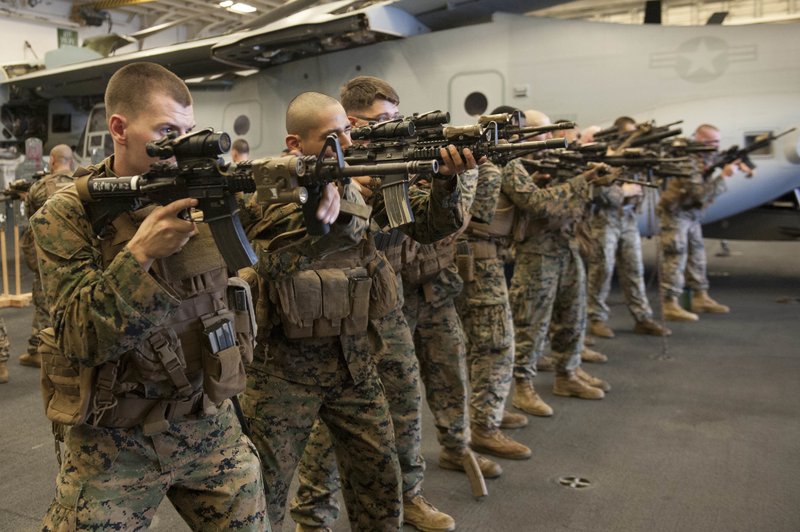A complex enterprise – shaping the future of US Marine Corps training
A recent briefing by the USMC set out what the service sees as its core training needs and how it hopes to deliver on them, as well as revealing several new requirements and initiatives.
Marine Corps Systems Command’s Program Manager for Training Systems (PM TRASYS) utilised this month’s Training & Simulation Industry Symposium event to provide a glimpse into current programme activities and anticipated near-term needs... Continues below
Newsletter Sponsors:

Above: The Combat Convoy Simulator is one a number of vehicle-based training devices due for modification or replacement as new platforms are introduced. (Photo: USMC)
The command briefing, presented on 12 June, highlighted a portfolio divided into four main segments: Synthetic Training Systems (STS), Range Training Systems (RTS), Warfighter Training Support (WTS) and Aviation Training Systems (Navy Projects – Marine Corps Supported).
One example of an STS effort needing a refresh is the Operator Driver Simulator (ODS), a legacy device that provides high-fidelity training for motor transport operators, from basic skills to advanced operational levels, by simulating the visual, aural/audio, haptic and dynamic motion cues of a tactical vehicle.
Briefers alerted industry to anticipate a future requirement to replace this system in FY2025, pending availability of funds and an approved requirements document.

MVRsimulation’s VRSG: bringing military simulation training to life.
Another STS project is Combat Vehicle Training Systems (CVTS), ‘a high-fidelity computer-based, interactive simulator that provides individual, crew, section and platoon training’ for precision gunnery and mission tactical skills to the USMC’s light armoured reconnaissance and assault amphibian communities.
A planned ‘system tech refresh’ for the LAV-25 amphibious armoured reconnaissance vehicle is now complete for all planned sites and, once again, industry should anticipate a future requirement to replace the legacy training system.
New requirements or changes to existing ones were also flagged for STS programmes such as the Indoor Simulated Marksmanship Trainer and Combat Convoy Simulator.
The briefing also highlighted several programmes under the RTS segment, including the Multi-Use Egress Trainer (MUET) which is intended to replicate newer vehicle systems that are coming online as other types become obsolete or are retired. MUET will replicate the Amphibious Combat Vehicle, Joint Light Tactical Vehicle and Light Armored Vehicle.
MUET will be interoperable with the USMC's four existing and two planned egress training facilities. The acquisition strategy for a total of six trainers focuses on a partnership with the Naval Air Warfare Center Training Systems Division on existing IDIQ contracts, with a production award projected for the first quarter of FY2025.
Under the WTS sub-portfolio, PM TRASYS outlined multiple activities, including Marine Air Ground Task Force Training Systems Support (MTSS), described as ‘a Multiple Award Contract [MAC] in March of 2019 that is primarily aligned with the Knowledge Based Training Services (KBTS) Portfolio Group’.
The contract is structured for maximum flexibility, providing an expedited ordering process to procure KBTS to satisfy training and education requirements for Training and Education Command organisations.

Identified current vendors include American Systems Corp, Corps Solutions, Calibre Systems, Obsidian Solutions. Science Applications, Solutions Through Innovative Technologies and Valiant Global.
Multiple contracts have also been awarded for Electronics and Communication Services, which includes sustainment support for ‘relatively complex items of training equipment, using software applications to represent conditions of combat operations necessary for multiple echelons of training’.
Vendors here include AVT Simulations, Choisys Technology, Corps Simulation & Cyber Solutions, Dignitas Technologies, Engineering & Computer Simulations, Envision Innovative Solutions, and Tactical Edge.
Under Equipment Related Services – Systems (ERS-S), PM TRASYS awarded an MAC in March 2021 to Ahtna, Guard Unit, Hatalo, and Shock Streak which was intended to be broad in nature and entail sustainment support for existing and future USMC training systems.
Its scope covers maintenance, logistics and training requirements, for complex items of equipment using ‘electronic/mechanical means to reproduce conditions necessary for an individual or a crew to rehearse operational tasks’. Simulators, one could say.

Above: Marksmanship training is also under constant review, with simulated environments increasingly used instead of the real-world drills seen here. (Photo: USN)
Also falling under this portfolio is the Advanced Small Arms Lethality Trainer (ASALT), a KBTS effort providing marksmanship subject matter experts, scenario planning and design, training concepts, virtual range operations, AAR capabilities and system support to modernise weapons proficiency training. It aims to provide a high-quality user experience through enhanced individual and team/squad drills, digital scoring and advanced techniques within a simulated environment.
The briefing also identified several new requirements emerging in 2024, including a capability needs statement for Marine Air Command and Control System simulation, a requirements memorandum for the Enterprise Ground Maintenance Training System, a directed requirement for a Low-Fidelity Driver Trainer, a capability requirement change for a Deployable Virtual Training Environment and Live Virtual Constructive Training Environment, and an annex to an Existing capability development document for a Live Fire Evaluation Tool.
The briefing shows the complexity of a modern military training enterprise, especially for an inherently multi-domain force such as the marines, with a framework of support and services contracts underpinning more visible range and simulator elements. And industry should be on the alert for future opportunities across a range of existing and forthcoming USMC programmes.
Other articles in this newsletter:
Combat casualty care training – special forces need special approach
Reality check – how the US Army is learning training lessons from current conflicts
Don't want to miss out on future Decisive Edge content? Make sure you are signed up to our email newsletters.












